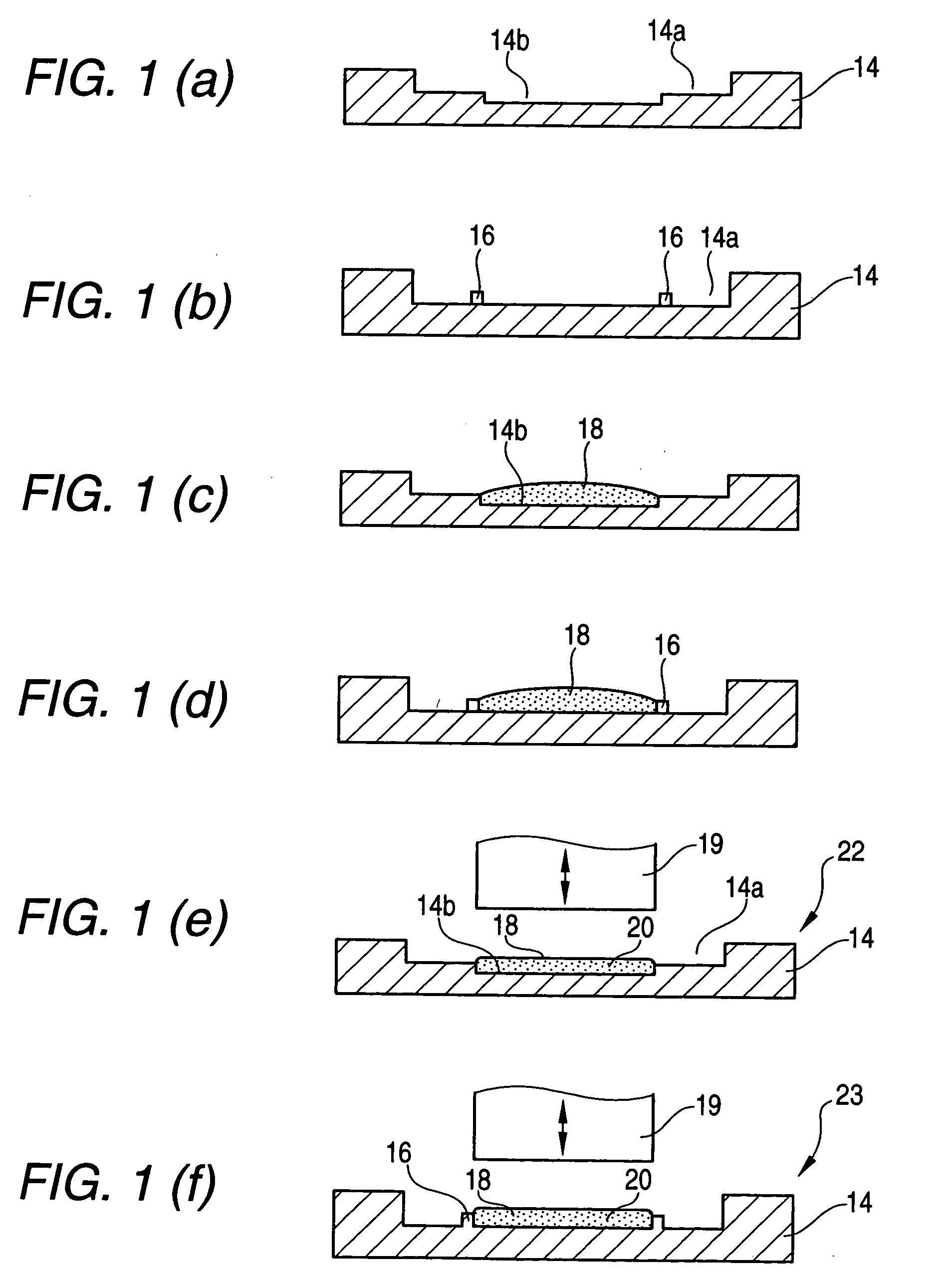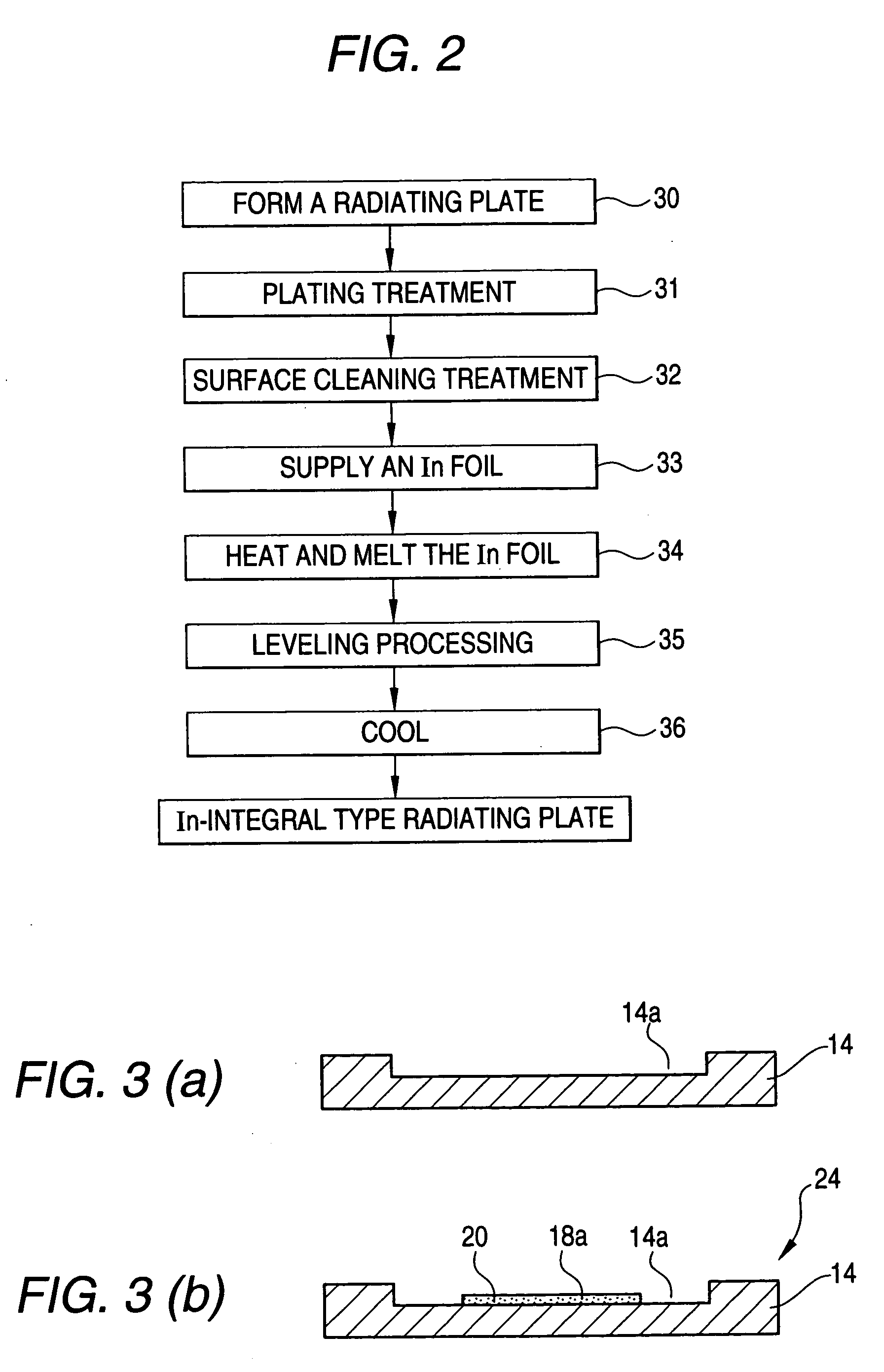Method of manufacturing radiating plate and semiconductor apparatus using the same
- Summary
- Abstract
- Description
- Claims
- Application Information
AI Technical Summary
Benefits of technology
Problems solved by technology
Method used
Image
Examples
first embodiment
[0032] FIGS. 1(a) to 1(f) are the explanatory views showing a process for manufacturing a radiating plate according to the invention and FIG. 2 is a flowchart showing a manufacturing process according to a first embodiment.
[0033] FIGS. 1(a) and 1(b) show a state in which a radiating plate 14 is formed to take a predetermined shape at a radiating plate forming step 30 using a press processing shown in FIG. 2.
[0034]FIG. 1(a) shows a state in which a housing concave portion 14a is formed on the base material of the radiating plate 14 and a concave portion 14b is formed in the central part of the housing concave portion 14a. Both the housing concave portion 14a and the concave portion 14b take a rectangular planar shape in the embodiment.
[0035]FIG. 1(b) shows another example of the structure of the radiating plate 14, in which the housing concave portion 14a is formed on a base material by a press processing and a resin material such as an epoxy resin is then applied like a frame ont...
second embodiment
[0052] In the method of manufacturing an In integral type radiating plate according to the embodiment described above, the In foil is heated and molten and the In-containing thermal conducting bonding material 20 is adhered integrally with the radiating plate 14. Second and third embodiments which will be described below are characterized in that it is possible to obtain the In integral type radiating plate, having the radiating plate 14 and the In foil integrated with each other, by only causing the In foil to come in contact with the radiating plate 14 under room temperature as it is without need of heating and melting the In foil.
[0053] FIGS. 3(a) and 3(b) show the structures of the radiating plate 14 to be used in the second embodiment. In the second embodiment, an In foil is exactly adhered to the radiating plate 14 and the In foil and the radiating plate 14 are thus integrated with each other. For this reason, it is not necessary to provide a concave portion 14b and a barrier...
third embodiment
[0067] While the first plating and the second plating are carried out over the radiating plate 14 and the electrolytic treatment utilizing an electrolyte is then performed as the surface cleaning treatment for the radiating plate 14 in the second embodiment, a third embodiment is characterized in that a sulfuric acid solution is used to carry out the surface cleaning treatment for the radiating plate 14.
[0068] Since the structure of the radiating plate 14 and the contents of treatments in a first plating step 37 and a second plating step 38 are completely identical to those in the second embodiment, description will be omitted.
[0069] At a surface cleaning step 39 in the embodiment, the radiating plate 14 subjected to the first plating and the second plating is immersed in 1N sulfuric acid, and subsequently, an In foil is immersed in a dilute sulfuric acid solution and is put stationarily for 30 seconds or more, and the In foil is then pressed against the radiating plate 14 so that...
PUM
 Login to View More
Login to View More Abstract
Description
Claims
Application Information
 Login to View More
Login to View More - R&D
- Intellectual Property
- Life Sciences
- Materials
- Tech Scout
- Unparalleled Data Quality
- Higher Quality Content
- 60% Fewer Hallucinations
Browse by: Latest US Patents, China's latest patents, Technical Efficacy Thesaurus, Application Domain, Technology Topic, Popular Technical Reports.
© 2025 PatSnap. All rights reserved.Legal|Privacy policy|Modern Slavery Act Transparency Statement|Sitemap|About US| Contact US: help@patsnap.com



